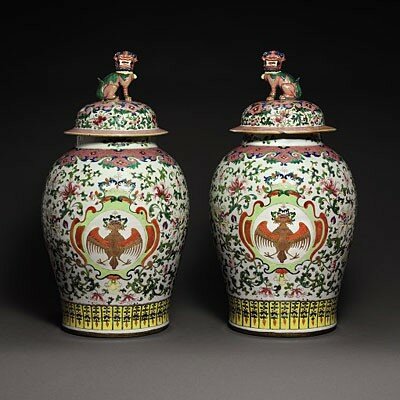Christie's London : A pair of large famille rose armorial jars
Lot n°245. A PAIR OF RARE LARGE FAMILLE ROSE ARMORIAL JARS AND COVERS FOR THE SPANISH MARKET - QIANLONG (1736-95)
Of baluster form, decorated on each side with a roundel enclosing a double-headed eagle surmounted by a stylised crown formed of leaves and surmounted by a small cross, reserved on a brightly enamelled ground of scrolling stylised flowering foliage and small gourds, the shoulder with a shaped collar of flower heads on a pink ground with deeper puce floral detailing, and a band of yellow floral petal-shaped lappets around the foot, the domed covers similarly decorated and surmounted by a well-modelled seated Buddhist lion
27¾ in. (70.5 cm.) high, wood stands (2) - Estimate £50,000-80,000
The double-headed eagle on these remarkable jars represents Saint Augustin, who was known as 'The Hipona Eagle', and the arms, or emblem, is most likely that of a Spanish Augustinian convent in the Philippines. The islands which were formerly known as the Saint Larazo Islands, were named 'The Philippines' after Philip II (1527-98), King of Spain (and of Portugal after 1580), following their conquest by the Spanish in 1565. The Spanish Augustinians were soon established not only in Manila, but also in Macao, Mexico and India.
While the main emblem of the St. Augustinian Order is a heart pierced by two arrows, Philip granted the Spanish Augustinian Order in the Philippines the privilege of using the Hapsburg eagle as their emblem, in recognition of their discovery of the miraculous image of the Holy Child at Cebu. During his research into the subject, Antonio Diez de Rivera consulted both the head priest of the Augustinian monastery in Manila, and Blas Sierra de la Calle, senior curator of the Oriental Museum in Valladolid, Spain, which is run by St. Augustinian priests, both of whom have studied the history of the Augustinian missions in depth. They were both of the opinion that Augustinian orders used several versions of the emblems, and that those using the eagle without the heart.
See the 18th Century rain cape (detail - fig. 1) embroidered in the style of shawls from Manila but made in Canton, which bears almost identical arms to those on these jars. Having come originally from the Philippines, this cape is now in the Oriental Museum in Valladolid, and was included in the exhibition 'Arte Chino y Filipino', Museo Oriental, Valladolid, 1990, catalogue, pp. 140-1.
During the last quarter of the 16th century there was a rapid increase in trade of spices, silks, lacquer, ivory and porcelain, which were transported from the Far East, especially China, to Spain from The Philippines via Acapulco, Mexico, and the capital, Manila, became a crucial trading centre, which also benefited from the cargoes of precious metals and American and European wares which were carried on the return journey back to the East. The earliest known examples of Chinese porcelain for the Spanish market are probably the blue and white jars bearing the St. Augustinian emblem of the double-headed eagle above a pierced heart, which date to circa 1575, when the Augustinians made the first of several expeditions to China. Such jars can be found in private and public collections around the world, including the Peabody Essex Museum, Salem, together with an extremely rare large dish similarly decorated, the Hodroff Collection (D. S. Howard, The Choice of the Private Trader, London, 1994, no. 272), a private collection in Mexico (J. McClure Mudge, Chinese Export Porcelain in North America, New York, 1986, fig. 49), and the Alpoim Calvão collection, Cascais (N. de Castro, Chinese Porcelain and the Heraldry of the Empire, Opporto, 1988, p. 29).
Compare the small famille rose jar and cover with the double-headed eagle motif, but lacking the crown and cross, illustrated by N. de Castro, ibid., p. 85, where it is attributed to a St. Augustinian Order.
Christie's London. FINE CHINESE CERAMICS AND WORKS OF ART INCLUDING EXPORT ART. 6 November 2007, 10:30 am. 8 King Street, St. James's, London - www.christies.com

/https%3A%2F%2Fprofilepics.canalblog.com%2Fprofilepics%2F1%2F0%2F100183.jpg)
/https%3A%2F%2Fstorage.canalblog.com%2F03%2F02%2F119589%2F96711876_o.jpg)
/https%3A%2F%2Fstorage.canalblog.com%2F11%2F31%2F119589%2F94773502_o.jpg)
/https%3A%2F%2Fstorage.canalblog.com%2F20%2F83%2F119589%2F94772815_o.jpg)
/https%3A%2F%2Fstorage.canalblog.com%2F26%2F72%2F119589%2F75604929_o.jpg)
/https%3A%2F%2Fstorage.canalblog.com%2F59%2F60%2F119589%2F26458628_o.jpg)



/image%2F1371349%2F20240518%2Fob_60d595_444216558-10227922422179103-2007077639.jpg)
/image%2F1371349%2F20240515%2Fob_4a80af_2.png)
/image%2F1371349%2F20240515%2Fob_a65d19_1-1.png)
/image%2F1371349%2F20240515%2Fob_d1ec88_telechargement-11.jpg)